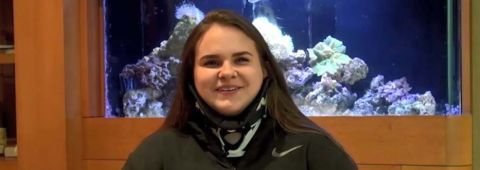
A teenager’s high-stakes spine surgery
Heather Gordon, an avid high school track athlete, had been experiencing increasing pain in her neck, head, shoulder and arm for more than three years.
Finally, at 17 years old, she underwent several tests to determine the cause of her pain. What she expected to be a sports injury from her shot put training turned out to be something much more serious: a tumor on the C3 vertebrae of her spine. It was pushing against her spinal column.
She faced a heartbreaking decision: a risky surgery to remove one of her vertebrae, or paralysis. While certainly not something she looked forward to, choosing surgery was a logical decision.
However, the doctors in her hometown of Tucson were inexperienced with the surgery she needed, so they suggested she meet with specialists at the Barrow Spine Program.
Scared and uncertain of what to expect, Heather’s fears were eased when she met Dr. Juan Uribe, chief of the division of spinal disorders at Barrow.
She says, “He was really focused and wanted to make sure I understood that this surgery was very complicated and serious.”
But Heather knew she was in the best hands. Dr. Uribe is a renowned neurosurgeon who specializes in the surgical treatment of scoliosis, spinal trauma and spinal tumors, particularly with minimally invasive techniques.
Doctors relieve dad’s anxiety about risky surgery
In a series of two surgeries, Dr. Uribe removed Heather’s C3 vertebrae and fused together the levels above and below it. The surgeries eliminated the tumor and almost all of her pain.
“I felt better instantly, and even right after surgery I was moving my head more freely,” Heather says. “My quality of life has changed completely.”
Heather’s dad, Tom Gordon, was anxious during the entire process. He reflects, “Dr. Uribe was very straightforward. He would bring in a model and show us exactly what he was going to do. I liked that. I want to know up front what’s happening. I thought he did a great job of explaining it and keeping us informed so we didn’t get too freaked out. After the surgery he asked about her track and showed he really cared about her.”
Heather looks forward to reaching two more milestones in her recovery – removing her neck brace and returning to competition in shot putting to earn a college scholarship.
Spine research gives patients hope
Barrow offers lifesaving treatments for the most debilitating brain and spine diseases, and many of patients’ lives have been transformed because of the care provided at the institute.
Recognizing that spinal surgery can be aggressive, Dr. Uribe is also leading cutting edge research for minimally invasive spine surgery to help patients like Heather. Research aims to develop robotic devices, improve diagnostic systems, produce novel surgical tools and create new procedures to effectively and safely treat spine disorders. At Barrow, doctors continue to strive to find less invasive procedures to deliver better outcomes, giving patients like Heather hope to return to healthy, active lives.

